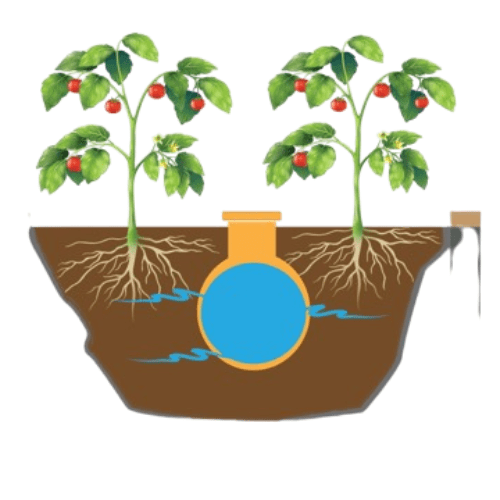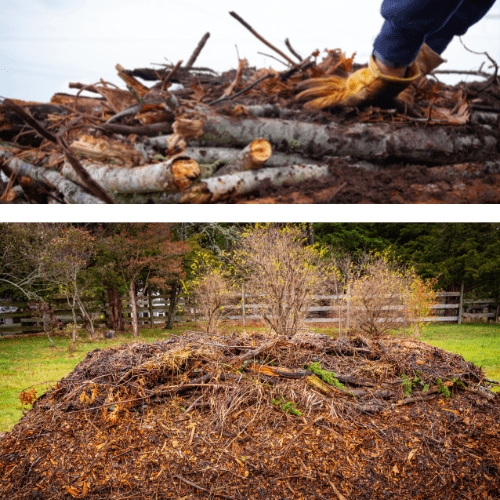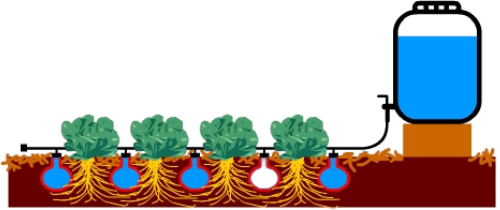How to set up a kids or school garden for less watering chore
Jul 25, 2022We live in a cold climate but our summers are crazy hot! We essentially jump from crazy cold to boiling and back to freezing again. Instead of 4 seasons, we have only 2.
What do we do to make sure my kids don't have to water their garden 3 times a day during the hot dry spells?
Our annual vegetable garden is sub-irrigated.
Watch the video at the top of this page where I show you exactly how we set it up in our container planters.
You can use the same method on a balcony, on a porch or deck, or even indoors.
But what if your kids' garden is in the ground?
There are a few methods of watering we've used over the years with my family, in the different houses we lived in... ya we've moved quite a lot lately... And these methods work well.
But I first wanna tell you what NOT to do.
I dislike sprinklers! They are only good for grass lawns and nothing else. Using a sprinkler to water your annual vegetable gardens or even your perennial shrubs and trees is one of the worst things you can do to your garden.
Sprinklers are a waste of water, they spread most of the water in the air where it evaporates, especially when it's hot and dry. A small portion of it lands on the leaves of your plants, which is not where the plants need it, and very little if any ends up on the soil at the roots. That is not enough at all as annual vegetable gardens need to be deeply watered.
And the water that ends up on the leaves, burns the leaves if it's sunny and creates fungal diseases if it's not.
So no sprinklers, please!
There are a few methods of watering which usually need to be previously set up. So it might be too late at this point if you have already grown a garden. But there are also a few methods to conserve water that you could employ right this very minute to help your garden. So let's talk about them...
Efficient watering systems:
1) Sub-irrigation as thoroughly explained in the above video, for container gardens
2) Olla pots
3) Soaker hose and drip irrigation
Water conservation methods:
1) Hügelkultur
2) Straw mulch
3) Living mulch
Olla Pots
This ancient technique is one of the coolest I've ever seen. I so enjoy teaching this to students. It's very intriguing to find out if it works or now and super exciting to see it work.
The concept is simple; you need to bury a reservoir that naturally gives water to the roots of the plants. This reservoir needs to be unglazed clay.
As long as the olla pot is filled with water, the plants around it will have exactly as much water as they need. Why? Because when the soil is wet, the water stays in the pot and as soon as the soil around the pot is dry, the water naturally seeps through the clay and into the soil.
No over or underwatering ever happens! And no waste!
And water is given exactly to the plant part where it needs it, the roots.
I just love olla pots so much!
The only thing with them is, that they do take up some space inside the soil. But that is a sacrifice I'm willing to make and honestly I never heard my plants complain! ;) And my kids plant densely as you can see in the video above.

Soaker hose and drip irrigation
These are also effective, especially drip irrigation, but they have a big downfall in my opinion and that's the fact that they do impose an expense to be set up with good quality and less plumming problems to fix in the long run.
We had soaker hoses in one of our houses before and honestly, they broke here and there and gave us maintenance headaches several times during one season. My guess is, that we probably didn't use the best quality hoses to avoid a huge expense.
Also, these systems work better with smaller gardens. if your garden is big, the pressure on your tap might not be able to take the water to the ends of your garden which means you need to invest in more equipment to fix the lack of pressure.
We had this issue as we were watering a permaculture garden with lots of fruit trees and shrubs back then and the soaker hoses were very long. By the time the water got to the end of each soaker hose, there was not enough pressure to push the water out of the hose so, we needed to hand water some areas.
I like drip hoses better though as they don't have another issue that soaker hoses have and that's the fact that they clog! Not the first year, but starting the second, if your water is hard, the soaker hoses start to clog which means you'll need to completely throw them out and replace them. And that, to my inner-environmentalist, is a sin, my friends! I hated that about soaker hoses.
Is it possible that I didn't get the best quality of soaker hoses and had the hardest water? Maybe! Feel free to jump in and let me know if you've had a better experience with soaker hoses. But so far, I'm not a fan!
I very much prefer working with mama-nature to water with the least artificial equipment that requires maintenance. And that brings me to my favorite method of all, Hugelkultur, an amazing water conservation technique!
Water conservation techniques:
Hügelkultur
That's a fancy word for a pile of wood, topped up with soil!
You could bury the wood or you could put it on the ground and mount the soil on top. Either way, it works.
If you are a teacher, I'd like to invite you to pay extra attention cause building a Hugelkultur garden could be an activity that's a lot of fun for your students and it also significantly reduces the watering chore during summertime vacations.
Why is this my favorite method? Because the wood simply acts like a sponge. It absorbs the spring rains and water that's given to the garden by hand and holds on to it only to release it to the roots of the plant gradually during the dry season.
It's also a long-term soil building technique as the wood slowly decays and gives out lots of goodness over time.
I've had amazing jaw-dropping success with Hugelkultur in schools and at home and highly recommend it.

Straw mulch
Everyone knows that mulching the soil is a good way to keep the water from evaporating and the soil from eroding through wind and wash-ups.
But when one says mulch most people think of wood mulch. Even though wood mulch is great for perennial trees and shrubs, it's not ideal for vegetable gardens. Chopped-up wood steals nitrogen from the soil as it decays quickly and since annual vegetables need that nitrogen and need it quickly, they can suffer as the decaying wood mulch wins.
But what's highly recommended to mulch your vegetable garden with is straw.
Just make sure you get straw and not hay, as hay contains seeds and could create a weeding nightmare in your vegetable garden!
Living mulch
Living mulch is my favorite mulch of all. It refers to plants that grow close to the ground and cover it up. This not only conserves water but also prevents weeds from growing as it creates shade.
These plants could be of what I call herby type, that you sprinkle the seeds of and grow them densely, like leaf lettuce, white clover, arugula, parsley, coriander, dill, etc. or could be of broad leave variety, those that cover a large area of the soil with their huge leaves. An example would be squash!
The above is not at all an exhaustive list of methods to employ for watering or water conservation. But in the spirit of keeping it short, I think it's a helpful list.
Do you have rain barrels for example? If you don't and you are legally ok to have them, go for it I'd say. Cause if you could use the water that mama-nature sends from the sky instead of using your tap water, why not?

Hope this helps! Keep cool and hydrated, I hope, you and your kids' gardens both!
Let me know your thoughts!
Leila

